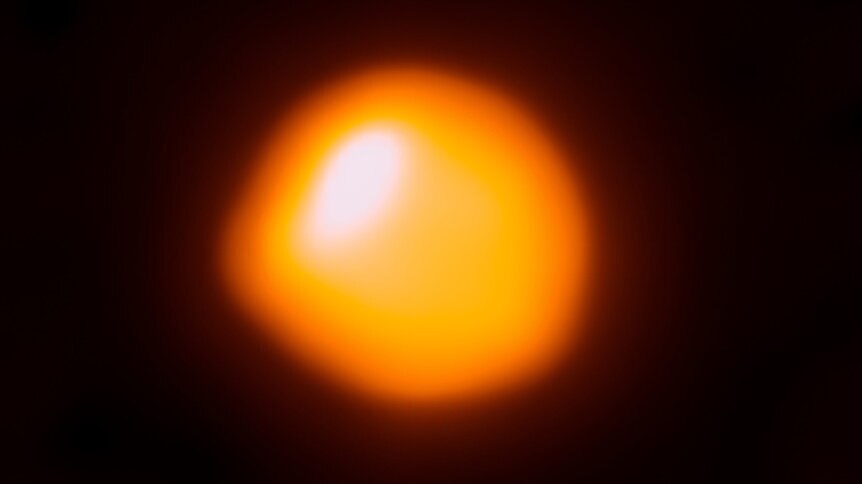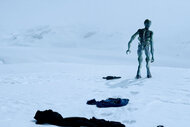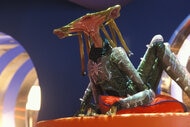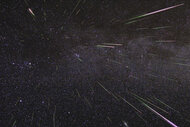Create a free profile to get unlimited access to exclusive videos, sweepstakes, and more!
Betelgeuse is lumpy! Except not really!
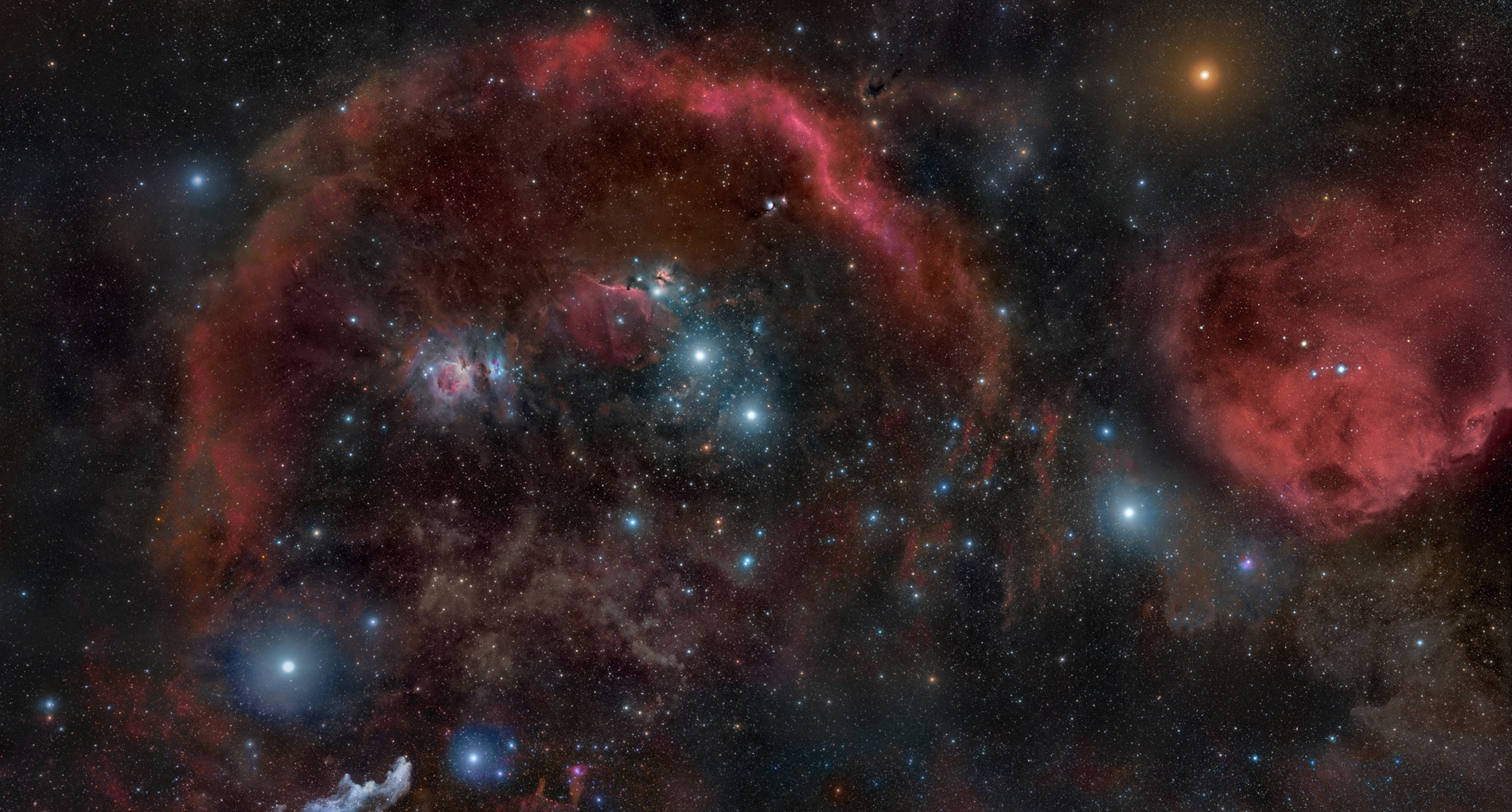
A new observation of the bright star Betelgeuse shows it's … odd.
[Credit: ALMA (ESO/NAOJ/NRAO)/E. O’Gorman/P. Kervella]
You can see it in that image (much bigger versions are available, too). The orange color isn't real; the observations were made using the Atacama Large Millimeter/Submillimeter Array (ALMA), which observes light way outside the color range our eyes can see. But the bright spot to the upper left is real, as is the gigantic lump on the left side, too. But here's the thing: That lump isn't really a lump, at least not a physical protrusion in the side of the star. It's actually a place where the star is warmer and denser, making it look like a lump.
I know, that's weird. Let me explain.
First, Betelgeuse is a red supergiant, a star much more massive than the Sun (about 20 times the Sun's mass) and nearing the end of its life. When a star like that runs out of available hydrogen in its core to fuse into helium, the core heats up. The gas above the core responds by expanding (just like a hot air balloon; when you heat a gas it expands). Furthermore, Betelgeuse is already on the next step, fusing helium into carbon and oxygen. That creates a huge amount of energy that gets dumped into the outer layers. When that happens a star's size increases hugely; depending on how you measure it, Betelgeuse is about a thousand times wider than the Sun!
Normally, stars are far too small to see them as anything other than points of light. But Betelgeuse is so big that our most powerful telescopes can resolve it into a disk. The ALMA image shows it to be about 0.1 arcseconds wide. Arcseconds are an angular measure; there are 60 arcseconds to an arcminute and 60 arcminutes to a degree. The Moon appears in the sky to be 0.5 degrees = 30 arcminutes = 1800 arcseconds across. That's 18,000 times wider than Betelgeuse!
So just seeing Betelgeuse at all as a disk in these images is pretty amazing. But it gets better.
When a massive star expands into a red supergiant, counterintuitively, despite the extra energy, the gas cools: That same energy is spread out over a lot more volume, so each cubic centimeter of the star has less energy in it. When the outer layer cools it goes from being blue-white hot to reddish, dropping to a temperature of a few thousand degrees Celsius, cooler than the Sun.
I described how this works in my episode of Crash Course Astronomy: High Mass Stars (at about the 2:30 mark):
Betelgeuse doesn't have an actual surface. It's a gas, and a pretty rarefied one at that. The density deep inside it is quite high, but by the time you get out into that outer part the density can be so low it's pretty much a hot vacuum.
So a funny thing happens when you look at it. The kind of light you see from the star depends on the density and the temperature of the gas emitting it. Deep down, it's hot and dense and the light is bluer – a wavelength of a few hundred billionths of a meter. Up near the top, the gas is cooler and thinner and is redder, with a wavelength twice as long. Gas farther out from the center emits even longer-wavelength light, with a wavelength around a millimeter or so.
That’s the kind of light ALMA is sensitive to. So what you're seeing isn't really the surface of Betelgeuse — which it doesn't have anyway — but just the gas in it that emits at that wavelength. The size you measure for a star depends on what kind of light you're looking at!
This is where that lump comes in. At a certain distance from the center of Betelgeuse, the gas is the right temperature and density to emit the light ALMA sees. Outside of that, it's cooler and doesn't emit that light, so it looks black. There is still gas there, but we just can't see it in the ALMA image. However, for some reason, in that one spot on the edge of the star there is some gas still warm and dense enough to emit millimeter light, and so we see it in the ALMA image as a lump, a local patch of gas warmer (and/or denser) than the gas around it.
That bright spot stretching across the upper left of the star may be the same sort of phenomenon as the lump, but we see it against the disk of the star, so it looks like a bright spot.
So what's causing this? It's not clear. It may be magnetic in origin. The Sun has a pretty strong and complicated magnetic field, and that can cause all sorts of odd features we can see. Betelgeuse has strong convection — hot blobs of gas rising from the interior, like water boiling in a pan — and we know that these blobs can have their own embedded magnetic field (the Sun does the same sort of thing). It may be we're seeing the top of a strong convection cell in Betelgeuse, with the gas heated by the magnetic field it carries.
I know this may seem a little esoteric, but it's actually pretty important. For one thing, we know that red supergiant stars blow tremendous winds of gas, like a super solar wind (Betelgeuse has a wind a million times stronger than the Sun's!). But we don't really understand the mechanism behind it. Magnetic fields may be important there, so studying Betelgeuse's upper atmosphere could lead to insight there.
Also, stars like Betelgeuse do one more thing at the ends of their lives: They explode. Like, supernova explode, sending huge amounts of gas several times the mass of the Sun screaming outward at a significant fraction of the speed of light! Betelgeuse is about 8 million years old and may only have about 100,000 years left before it goes bye-bye. At a distance of 650 light-years or so, it's probably too far from us to physically impact us, but it'll be bright when it explodes, about as bright as the full Moon. You'll be able to see it in the daytime.
These explosions create the heavy elements we need to live: The iron in our blood, for example, came from a star that blew up long before the Sun was born. Studying Betelgeuse gives us insight into this mechanism, which in turn is critical for our being here at all to study it!
Beyond that rather philosophical direction of thought, Betelgeuse is just amazing to observe. In 2013, astronomers observed that it had blown out an arc of gas as big as our solar system! It's also traveling through space, and the gas blowing away from the star will soon (well, in 5,000 years) hit a sheet of gas that will distort and interact with the star's wind. That should make for pretty pictures.
And, as you may know, Betelgeuse marks the right shoulder of the constellation Orion, and is bright enough that we can actually see its reddish color with the naked eye. I like showing it to people through my telescope when I can; the color is amazing, and it’s so bright it's like a ruddy gem in the eyepiece.
And I like knowing that, as beautiful as it is by eye, what we see is just one small bit of what Betelgeuse really is. If it had a surface, we'd barely be scratching it.
[The image at the top of this post is Orion by Rogelio Bernal Andreo; Betelgeuse is the bright orange star at the upper right. This is the best image of the constellation I have ever seen, and you can buy a print of it.]
